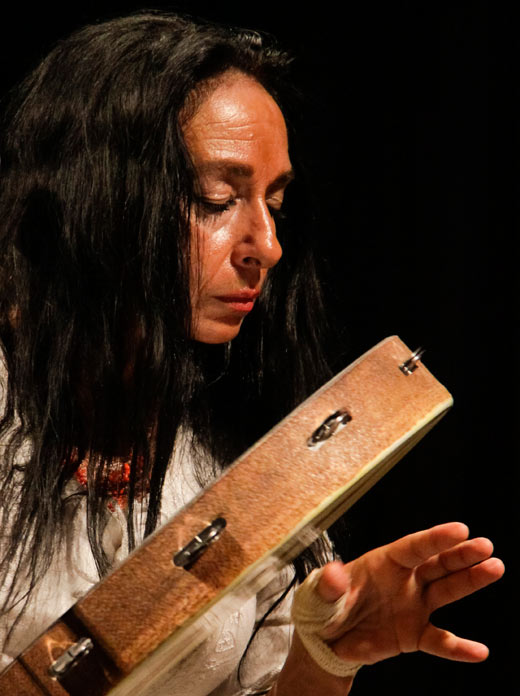BACKGROUND
In the United States, this powerful dance, the Tarantella is sometimes known as a silly wedding dance. In reality it is a wild, erotic dance of purification, performed mainly by women, to cure the mythical bite of the tarantula. The original name of the dance is pizzica tarantata.
Pizzica literally means “bite” — a reference to the “bite of love” that occurs when one’s subconscious mind is filled with repressed desires. This bite of love often begins during puberty and is caused by a repression of erotic desire or an experience of unrequited love, abuse or depression. A woman afflicted by this bite is called tarantata; she feels caught in a web, a web of societal repression.
In Greece, southern Italy, North Africa and Spain, when this mythical “bite” or mental condition afflicted women, their only cure was to be found through music and dance. We can date the origins of the tarantella back to the ancient orgiastic Greek rites of in honor of the God Dionysus. These rites were led by women who reached a state of euphoria, dancing to the rhythms of tambourines. Since ancient times, these rites have included powerful ritual music and trance dances that have been used across the Mediterranean for healing and purification.
The Tarantata work is dedicated to all women who have known the anguish and desperation of feeling trapped in a mythical spider web. My wish is to bring this ancient cure of wild dancing back to all women who need to free themselves from their spider webs and find their true expression.

THE DANCE CURE
When I started my research on the tarantate and the origins of the tarantella as music and dance therapy in 1982, I thought I was digging out traditions of the past. Many questions came up: who were these outcast women, who fell sick at the same time every year, and fell into a trance for days, dancing wild erotic dances in the villages and inside a church in Salento — an area in Puglia where women still have very little freedom or individual identity? I felt a deep connection with these women, felt their pain and depression as I had experienced it myself. Yet I did not grow up in that area.
I was determined to go to Salento to attend the annual Pizzica feast that happens every August 15th. I found myself to be the only woman playing tambourine, all through the night, bleeding on the skin of the drums, challenged by men to prove my strength. The first year that I won the challenge, I realized what I had done: I had broken the rules! Suddenly I attracted a lot of attention, became popular as part of the guys’ team of tambourine players— but at the same time I was rejected by the younger women.
The younger women today seem to have lost the strength possessed by the old peasant women who worked in the fields. These old women were capable of playing the drums for many hours during the festivals. The young women no longer work in the fields, and have thus lost their connections with the earth. They have regular jobs and have become more “civilized.”
I asked one of the players if there were still tarantate in the area. He replied, “Why? Don’t you know that you are one! We are all tarantati!” That’s when I realized there is a new form of tarantismo and that the young people in Salento still suffer from it. Like their forebears, they find the cure in the wild music, the tambourine playing, and the dance. |

Bringing the Practice Home
After playing and dancing all through the night, I felt great, falling asleep on the beach, awakening to a new flow of energy, feeling light and really good about myself. When I returned from Salento, I tried to bring that "cure" back to New York with me.
I healed myself from irregular bleeding with the dance canceled a surgery. I helped other women. I realized that you could become a tarantata anywhere.
Through the tambourine and the dance, I chose a new healing path, working primarily with women, teaching them how to find their inner power by drumming and breaking free through wild erotic dance.
I also began volunteering in the psychiatric department of Mount Sinai Hospital, through Dr. Elaine Hopson and Dr. Naomi Miller, teaching tambourine and dance to mental patients.
I use the pizzica tarantata as stress release and have patients create their own rhythms. This exhilarating experience reveals their incredible talents, bringing the patients joy and happiness. I also collaborate with a great spiritual healer, conducting special drumming and dancing workshops at the Healing Wisdom Center in the hills of Tuscany.
I strongly believe in the power of drumming and dancing. I also think that in our society there is a need to go back to this primordial way of healing. My wish is to pass this tradition on to women all over the world helping us to find the strength and courage to free ourselves from our social spider webs and, indeed, stop weaving them ourselves.

Southern Italian Frame Drum and Tambourine Tradition
In my research, I found that the Italian frame drum, tamburello, is an ancient musical instrument connected to rituals often associated with women, dating back to the ancient Egyptian and Sumerian cultures. In Magna Graecia (now Southern Italy) and the Middle East, women used the frame drums for rituals honoring the Moon Goddess. In Rome, both men and women played the tambourine in rituals honoring Dionysus and Cybele. This instrument is still used today in Italy to accompany folk dances such as tarantella, saltarello and tammoriata. |





